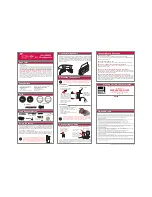
8
SPEAKER CONNECTIONS
Warning! To prevent possible personal injury and/or damage to your equipment, turn off
and unplug all equipment before making connections!
Before attempting to make any connections it is best to look at the situation, get all the
necessary materials together, and then make all the connections at once.
First, look at the back of your amplifier or receiver to determine what options it offers for
making connections. Amplifiers and receivers typically employ either 5-way binding posts,
spring-loaded terminals, or push terminals for the speaker connections.
A 5-way binding post can accept bare speaker wire, spade terminals, pin plugs, and banana
plugs, while spring loaded and push terminals can accept either bare speaker wire or pin
plugs. Refer to the documentation that came with your amplifier or receiver to determine
the maximum size/gauge speaker wire the speaker terminals can accept.
At the subwoofer end, all connections are made using screw terminals. While you can
make a bare wire connection, it is highly recommended to use Cable Lugs or Spade
Terminals. This includes the terminals for connecting the speaker wire from the amplifier as
well as those for connecting to the satellite speakers. The screw terminals will accept #6 or
#8 terminals/lugs with 4mm inside space and 8mm outside width.
The satellite speakers use Spring Terminals, which can accept bare speaker wire up to
14AWG or pin plugs. Pin plugs are recommended both for their convenience and their
ability to connecter larger diameter speaker wire.
Regardless of how you choose to make the connection you will need some speaker wire.
The thickness, or gauge, of the wire needed depends primarily on the distance over which
the signal will be sent. The following table serves as a guideline for determining the
minimum wire gauge to use in a standard 8-ohm installation:

































